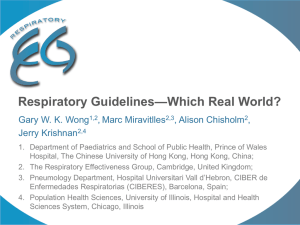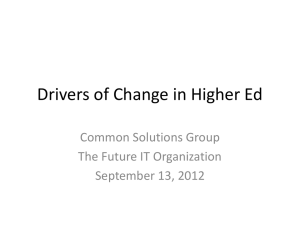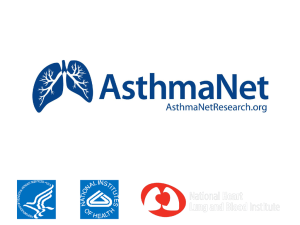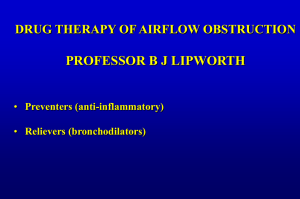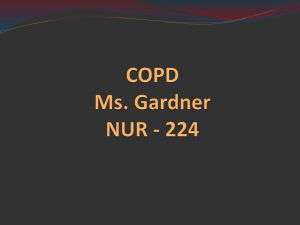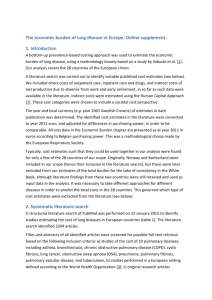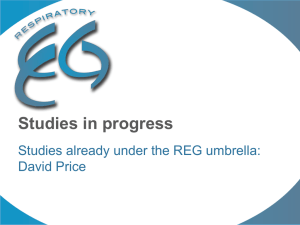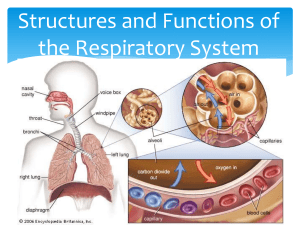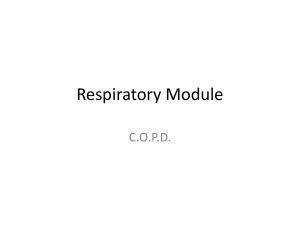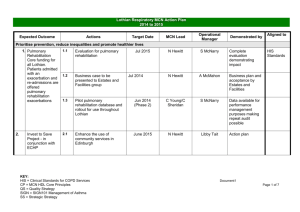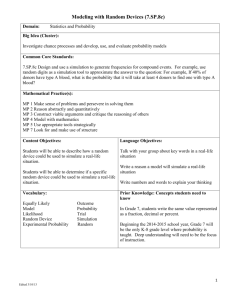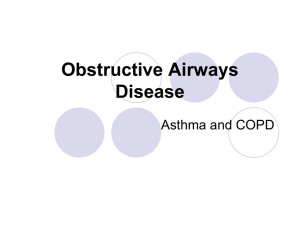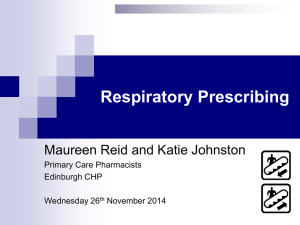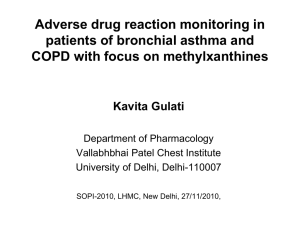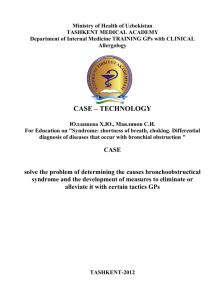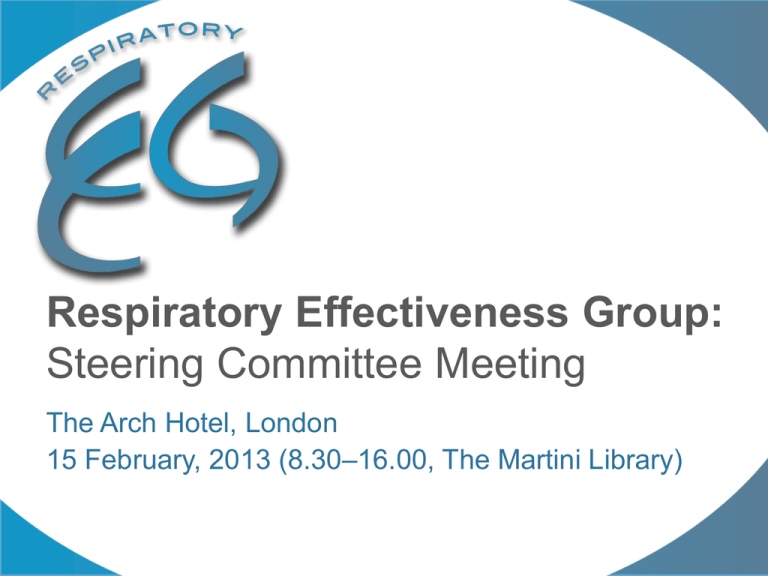
Respiratory Effectiveness Group:
Steering Committee Meeting
The Arch Hotel, London
15 February, 2013 (8.30–16.00, The Martini Library)
Meeting Objective
• Devise an action plan!
o Ideas: What are we going to do?
o Details: How are we going to do it?
o Priorities: When are we going to do it?
o Collaborations: Who’s going to do it?
o Funding: How can we make sure we can afford it?
Morning Agenda: 8.30–11:40
• 8:30–9:00:
• 9:00–10:20:
o Jon: 9:00–9:20
o Jerry: 9:20–9:40
o Richard: 9:40–10:00
o Leif: 10:00–10:20:
• 10:20–10:40
o Andrew: 10:40–11:00
o Gary: 11:00–11:20
o Marc: 11:20–11:40
• 11:40–12:30
Introductions & Updates (David / Alison)
Sharing Research interests
Comparative effectiveness Research: an
overview from the US
Analytic hierarchy to define priorities for
effectiveness/implementation research
The RO1 NIH submission / COPD gene group –
potential collaborations
Real-life effectiveness of different treatment
modalities of asthma or COPD in patients with
significant co-morbidities
BREAK
e-Health in COPD and asthma: tracking
exacerbations, guideline dissemination and
physician education
The fallacy of asthma guidelines: Discrepancy
between science and practice
The Respiratory Effectiveness
Group in COPD
LUNCH
Afternoon Agenda: 12.30–16.00
• 12.30–14.30:
Brainstorming how to turn the ideas into
reality
• 14:30–14:45
BREAK
• 14.45–15.30
Consolidating ideas and setting priorities
• 15.30–16.00
Other business
• Future meetings
• Engaging the wider group
• Securing sponsorship
• 16:00
MEETING CLOSE
Introductions
• Steering Committee
o David Price
o Jon Campbell
o Richard Martin
o Jerry Krishnan
o Andrew McIvor
o Leif Bjermer
o Marc Miravitlles
o Gary Wong
• Implementation Manager: Alison Chisholm
• Absent Committee Members:
Christian Virchow; Guy Brusselle; Nicolas Roche; Alberto Papi;
Nikos Papadopoulos; Stephen Holgate, Elliot Israel
Welcome and update
Evolving landscape: David Price
What have we achieved so far: Alison Chisholm
Studies underway already: David Price
8:30–9.00
Evolving landscape: timeline
2008
• Brussels
Declaration on
Asthma: stated
a need to include
evidence from
real world
studies in
treatment
guidelines
• Michael Rawlins
(NICE
Chairman): RCTs
should be
complemented
by a diversity of
approaches that
involve analysing
the totality of the
evidence base
2009
ATS/ERS
Large, prospective
studies in ʻrealworldʼ settings
(e.g., trials
designed
pragmatically to
reflect everyday
clinical practice) to
ensure they
provide content
validity as well as
reflect clinically
meaningful
outcomes
2010
ARIA / GA2LEN
Proposed the use
of composite
measures when
evaluating asthma
control and called
for the
measurement
properties to be
validated in clinical
trials
2011
NHLBI expert
workshop
Highlighted areas
that need
strengthening in
order to optimize
the potential of
reallife/comparative
effectiveness
(CER) research in
pulmonary
diseases, sleep,
and critical care.
2012
REG was
founded!
Drivers for change: EU perspective
• Clinical drivers:
o On-going need to improve patient outcomes
o Evidence-based decisions require representative data
• Budget pressures increasing the need to demonstrate:
o Affordability of therapies
o Value of therapies
• Pharma
o Bringing products to market is only the first step
– Licensing ≠ approved
– Licensing ≠ reimbursement
– Licensing ≠ usage
o Increasing need to invest in demonstrating the value proposition
for new and existing products
Clinical drivers: representative data
Population
•
•
•
•
Reversibility
Severity
Age / sex mix
Attitude to disease
•
•
•
Smoke exposure
Concomitant disease
Individual variation in
response
Efficacy
x
“real-life”
population
of patients
Effectivenes
s
Clinical drivers: representative data
Criteria for selecting asthma patients to a clinical trial:
o
o
o
o
o
o
o
Lung function 50–80% predicted
Bronchodilator reversibility
No co-morbidities
Non smokers or ex-smokers <10 pack years
Good treatment compliance
Symptomatic and regular relief medication use
Good inhaler technique
Travers et al. Thorax 2007
Norwegian study of asthma patients
to identify who would be eligible for
standard clinical trials
1.2%
Patient population
Herland K, et al. Respir Med. 2005;99:11-9
Clinical drivers: representative data
Does it matter if we exclude patients with:
o Lesser reversibility than 20%
o Active rhinitis
o Smokers
o Lower adherence
o Poor inhaler technique
AND
o Design the study not like real-life?
o Study only lasts 3 months?
Clinical drivers: representative data
Evidence
Theoretical
Theoretical
model provide
rationale
Classical doubleblind doubledummy RCTs
Gold standard,
large range of
outcomes.
But not “reallife” patients,
compliance and
represent <10%
of patients
Pragmatic
trials
Observational
Data
More real-life
Broader inclusion
criteria Allow
normal factors to
occur usually
randomised.
Simple outcomes,
but still consent &
rigorous
Real-life patients
Not randomised
Routine data
Normal decisions
Difficult to ensure
group comparability
Matching of case
controls,
adjustment
Real-life studies
Evidence base: hierarchy—continuum
Contemporary
TraditionalView
View
Evidence continuum – complementary study designs
RCTs
RCTs
Pragmatic
Observational
trials
studies
Pragmatic
studies
Experiment, observation, mathematics, individually and
collectively, have a crucial role in providing the evidential basis
for modern therapeutics.
Arguments about the importance of
Observational
each are an unnecessary distraction. Hierarchies of evidence
studies
should be replaced by accepting
– indeed embracing – a
diversity of approaches.
Sir Michael Rawlins, Head of NICE, Lancet 2008
Commercial drivers…
• Testing What We Think We Know. New York Times August 19, 2012
“The truth is that for a large part of medical practice, we
don’t know what works. But we pay for it anyway.”
H. Gilbert Welch, MD,Geisel School
of Medicine at Dartmouth
Commercial drivers…
• Drugs must be shown to:
o Be safe
o Be efficacious
o Address an unmet
clinical need
But also to be:
o Cost-effective
o Affordable
o …“value propositions”
Development of guidelines
Interventional
studies
(RCT):
Efficacy
Observational
studies
(pharmacoepidemiology):
Safety
Safety
Costeffectiveness
Effectiveness
Effectiveness
The future of drug research
• Multiple rich heterogeneous and intricately constructed ‘real
world’ data sets of Electronic Medical Records and
Transactional Claims databases
o Surveillance approaches are now being innovatively
applied to such data
o Several international initiatives and partnerships doing
essential foundational work in the field
o Challenging how to determine how to best utilise this
wealth of data, and how to best incorporate such analyses
into overall safety strategies
• Analysis of real world data is only one potential component of
an overall continual assessment of risk benefit
However… there are challenges
Obstacle
Solution?
No standard methods or endpoints
Carry out validation studies
Set standards
Enforce minimum planning by
offering study registration
Concerns around internal validity
and confounding of results
Match patients
Explore different matching methods;
set gold standard
Cynicism around retrospective data
mining
Promote and facilitate a priori study
registration
Limited understanding of how to
interpret the data
Educate and raise awareness
Limited penetration of the data:
– to high impact journals
– clinical guidelines
Address the issues above, and the
data will start to talk for itself…?
Set up REG an international,
collaborative approach





